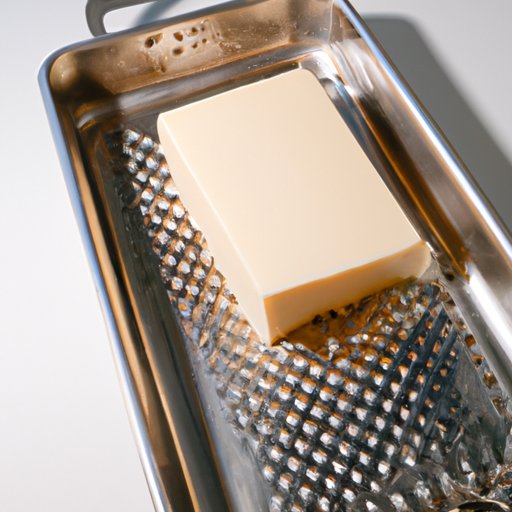Introduction
If you’ve ever tried to start baking a recipe only to realize that your butter is hard as a rock, you know how frustrating it can be to wait around for it to soften. Softened butter is a key ingredient in many baked goods, allowing for the proper texture and consistency of your final product. But fear not, because we have gathered all the tips and methods you need to soften butter quickly and efficiently.
5 Foolproof Ways to Soften Butter for Your Baking Needs
The first section of our article is focused on traditional and non-traditional ways to soften butter. Listed below are the five most foolproof ways to do it with a breakdown of each method’s pros and cons.
Method 1: Leave It Out Overnight
This is the most traditional and time-consuming method. Just take out the amount of butter needed the day before and let it sit on the countertop. It will soften on its own due to the room temperature, ready for use when needed. The downside is that you need to plan ahead and might risk over-softening in warm environments.
Method 2: The Warm Glass Trick
Run a glass under hot water then letting it sit over the piece of butter you want to soften. The warm, steamy air will soften the butter in just a few minutes. The pros are that it is a quick method and you only need a glass and water. The cons are that it takes time to heat the water to the right temperature and that you risk melting your butter if you leave it for too long.
Method 3: Grater Technique
You can use a cheese grater to shred your cold butter into tiny pieces. The smaller pieces will soften in a few minutes, and it is easier to mix in a recipe. The pros are that it is a quick process, and you won’t overheat your butter while melting it. The cons are that you need to clean a grater, and the resulting little flakes can make a mess.
Method 4: The In-Between Method
If you forget to take your butter out, cutting it into small cubes will quickly and evenly soften the butter without risking melting. Leave the cubes in a warm place for a few minutes and use it as soon as it softens. The pros are that it is a quick method that you can do while you prepare the other ingredients. The con is that you still need to plan ahead by warming the butter in a warm space and the little cubes may still take some time to soften.
Method 5: The Microwave Method
The microwave is an excellent way to soften butter quickly. Start by nuking 5-10 seconds but ensure to watch your butter carefully as microwaves tend to melt butter. Repeat nuking every 5-10 seconds until soft. The pros are that it is a quick and convenient method. The cons are microwaving butter can make it overcooked and unsuitable for recipes that have to be precise.
From the Freezer to the Microwave: The Best Techniques for Softening Butter
If you’re running low on time, put your butter in the microwave straight from the freezer. In just a few seconds, your rock-hard butter will be usable once again. However, you must monitor it to prevent melting or overheating. It is critical to use the defrost mode to ensure uniform thawing.
Getting Your Butter to Room Temperature: Tips and Tricks for Easier Baking
Many recipes specifically call for room temperature butter because it combines more efficiently with other ingredients. Keeping butter at room temperature is easier than you think. It would take roughly an hour to ensure the butter reaches room temperature. Soften butter in a low oven, plastic bags, or aluminum foil. This is an efficient alternative if you are prone to forgetting to leave butter out overnight.
Butter Softening Hacks: Creative and Efficient Methods to Save You Time
Various unconventional methods have been used to soften manually and automatic butter, such as pounding or rolling it with a rolling pin. The advantage is that it requires less time than traditional methods, which allows you to enjoy freshly baked homemade treats quickly. However, if you’re working on a recipe that requires precise measurements and particular instructions, make sure to stick with traditional methods.
Breaking Down the Butter: Understanding Different Softening Methods
Softening butter is a science. It’s critical to understand the fat complex in butter to properly soften it. The different methods do more than just soften the butter. Butter can either be softened in a subtle or prominent manner. Understanding the fundamental principles of softening butter through different means will solve issues with wrongly softened butter and create beautifully baked treats.
Step-by-Step Guide: How to Soften Butter Quickly and Effectively
Here’s the most effective method of safely and efficiently softening butter to the proper temperature for all your recipes:
- Begin by using the microwave to melt the butter for five seconds.
- To make sure it melts evenly, move it midway through the process.
- If your butter still isn’t soft enough, keep nuking it for five seconds until it becomes soft.
Watch the butter closely while microwaving to check it doesn’t melt or overheat. When ready, mix it with other ingredients, then bake and enjoy!
Conclusion
In conclusion, softening butter is a fundamental step in baking. We hope that this guide has given you sufficient knowledge of safely and efficiently softening butter by selecting the techniques suitable for each recipe. Softened butter creates the perfect texture and taste of any baked goods.
